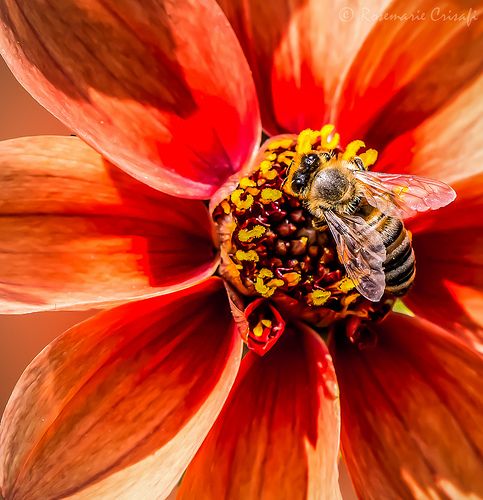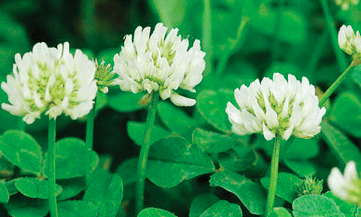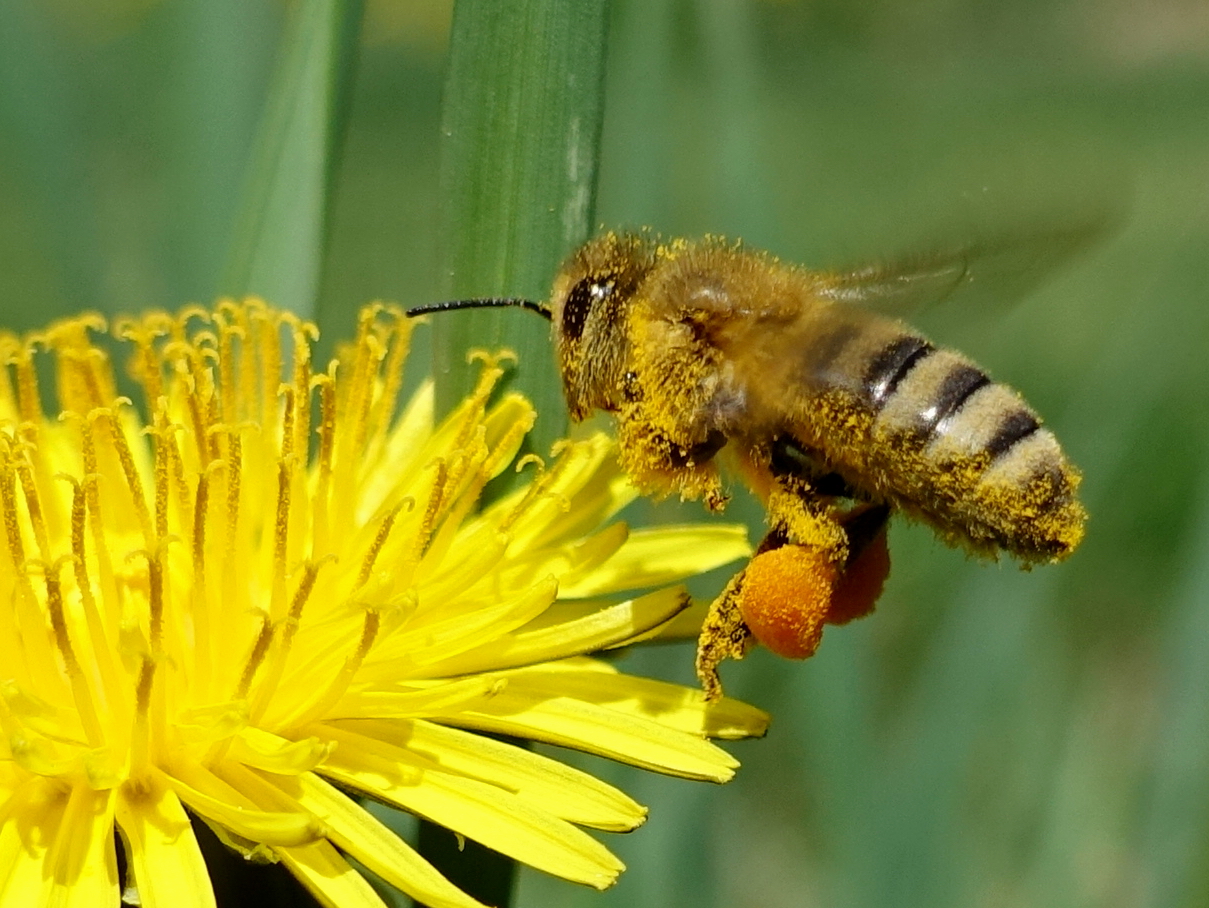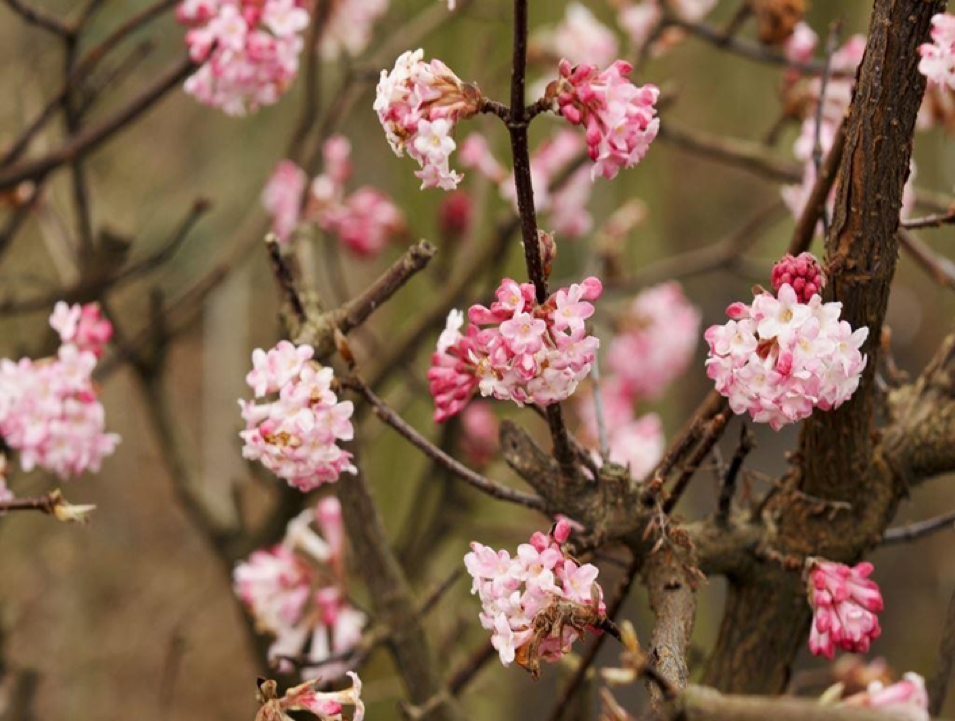Courtesy of Stuart Hatton and David Fray
July
Borage (Borago officinalis)
Borage is not a native to the UK – it is found in the Mediterranean and Middle East but grows well as a garden plant. Its beauty [and curse] is that, as an annual, it self-seeds freely. So a packet of seeds gives you plants forever!
 But it is a great bee plant. Beautiful, star-shaped, open flowers, pink initially, maturing to a deep, striking blue. It grows rapidly and starts flowering quickly. Plants will continue until the autumn frost. A bit straggly in habit but you can forgive it that for the abundant flowers which hang down, preventing rain from washing out the nectar. The leaves are hairy, rather irritating to the skin, but smell of cucumber; an ingredient of Pimm’s.
But it is a great bee plant. Beautiful, star-shaped, open flowers, pink initially, maturing to a deep, striking blue. It grows rapidly and starts flowering quickly. Plants will continue until the autumn frost. A bit straggly in habit but you can forgive it that for the abundant flowers which hang down, preventing rain from washing out the nectar. The leaves are hairy, rather irritating to the skin, but smell of cucumber; an ingredient of Pimm’s.
It produces large amounts of nectar. Borage honey is very pale, disinclined to granulate, runny and mild in taste. The pollen is white or grey. It is grown in small quantities commercially, in Yorkshire and the South of England and is much prized as a honey crop. It grows freely in my garden and I like to think it enhances my home apiary honey…
May
Dandelion (Taraxacum officinale)
The dandelions have started blooming in the past week [early April] and I can hear gardeners gnashing their teeth. Much disliked as a pernicious weed, it is a valuable plant for bees for both pollen and nectar.
Dandelions do not require pollination – they produce their seeds asexually, producing clones of themselves. This could be a problem if conditions change as they cannot adapt. They seem to be doing pretty well at the moment, though!The bright yellow flowers are packed with individual florets which are short enough for honey bees to access. The nectar is high in sugar – averaging up to 55% which is significantly higher than apple blossom. Nectar sugar levels are highest in warmer weather and more nectar is secreted by larger flowers. Flowers produce more on their second day. Apple producers remove dandelions from their orchards to encourage bees to visit the apple flowers rather than the more attractive dandelions.
The pollen is produced in large amounts. It is bright yellow and a useful adjunct to larval food but lacks 4 essential amino acids so needs to be mixed with other pollens for a balanced diet.
Wax produced from dandelions tends to be yellow. The nectar is said to smell slightly unpleasant. I noticed my hives were giving off a strong, not-entirely-pleasant smell last year in April/May and suspect it was a good dandelion flow. Like most early nectar flows, however, most gets consumed in the rapidly enlarging brood nest at this time of year.
April
Amelanchier lamarckii
Amelanchier are commonly known as June berry or Snowy Mespilus and usually flower in April. The small white 5 petal star shaped flowers are followed by round purple shaped fruits which soon get eaten by blackbirds and pigeons. The foliage is initially coppery coloured which turns to green as the flowers fade. Amelanchier are known for attracting bees and other pollinators with their pollen and nectar rich flowers. They grow in all types of soil but thrive best in acid soil in sun or partial shade and can either be grown as a shrub or a small tree. If grown as a tree they can attain a height of 4-5 metres in 10 years. It is an excellent tree for providing autumn colour with the foliage turning to shades of yellow, orange and red before the leaves fall.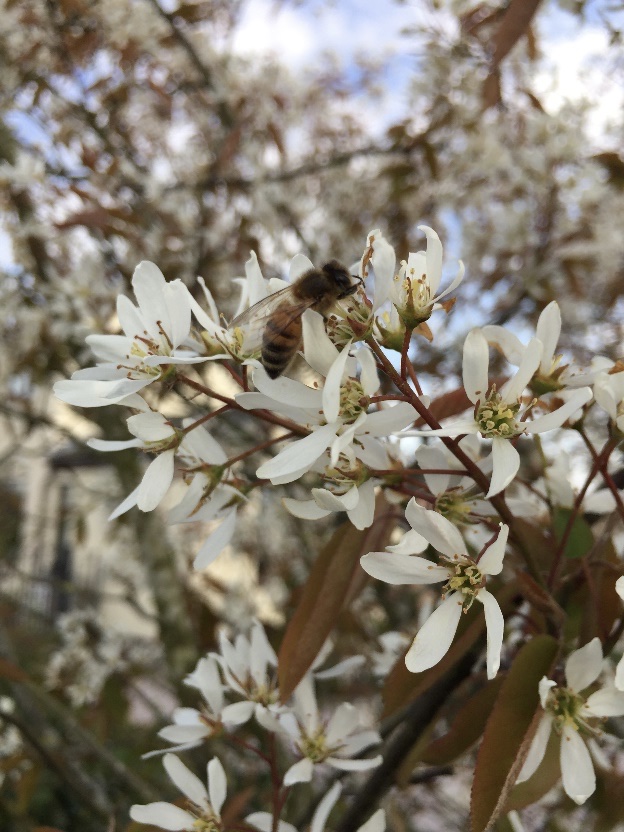
Amelanchier can be hard pruned but this will reduce the amount of flower in the following season. Better to prune little and often after flowering in the spring.
Sycamore (Acer Pseudoplatanus)
This much-maligned tree can be very important to bees towards the end of April and early May. An introduced species, possibly 500 years ago, it has spread rapidly due to its prolific, winged seed production and the saplings’ shade-tolerance, allowing it to grow where other native species cannot.
Given a period of warm weather in spring, a good nectar flow can be had, though it is mostly used up in brood production at this time, even if it is stored. The nectar can be around 50% sugar, making it a valuable source of forage. Large aphid populations feeding on the leaves are good for birds and produce significant amounts of honeydew.
Pollen loads are a khaki colour and pollen is produced in good quantities. The flowers, easily visible before the leaves fully develop, are yellow/green panicles with both male and female flowers together. Flowering lasts 10 days or so, but onset varies with the position of the tree so with lots of local sycamores, the ‘nectar window’ can be longer. Stand under a good sized tree on a warm day in spring and you can hear the bees’ hum as they work the flowers.
Mature, isolated trees can be magnificent. Given the spread of ash dieback disease, we may be grateful for the sycamore. Natural England and other Conservation Groups are changing their attitude to it. Its value to other insects and birds has been under-estimated, so perhaps not only beekeepers should value it. Just don’t park your car under one.
March
Almond (Prunus dulcis)
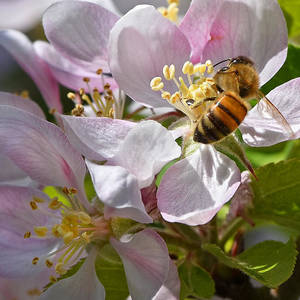 The Almond tree is native to a Mediterranean climate area of the Middle East and Western Asia. In the UK it is mainly grown as an ornamental tree reaching up to 30’.
The Almond tree is native to a Mediterranean climate area of the Middle East and Western Asia. In the UK it is mainly grown as an ornamental tree reaching up to 30’.
Almonds flower very early in the year and produce masses of light pink flowers from mid-February to March depending on the location. With flowering so early it is prone to spring frosts which turn the flowers brown. These days with climate change we sometimes have a few days of good warm weather allowing the bees to fly and take advantage of the nectar and pollen which is produced in abundance on the Almond. The flowers often appear much to early to be of use to solitary and some bumble bees.
When growing Almonds in the UK plant in full sun and well drained soil in an area protected from North and Easterly winds.
Almond also belong to the cherry family and have extra floral nectaries at the base of the leaves. They are close relatives to the Peach and Nectarine and all can suffer from Canker and Peach Leaf Curl.
Varieties of Almond offered for sale are:
- Prunus dulcis most commonly offered.
- Robijn is a continental selection with improved quality and yield.
- Ingrid is a new variety that is said to have better disease resistance.
February
Snowdrop (Galanthus nivalis)
The snowdrop is the earliest of the spring bulbs to come into flower and if the weather is warm enough honeybees take advantage and feed on the nectar and pollen to assist in building up colony numbers for rearing brood for the coming year. Snowdrops can be in flower for about 6 weeks but often flower too early for some bumble and solitary bees to take advantage of. Snowdrops grow best in moist but well drained soil in partial shade. The small snowdrop bulbs are prone to drying out, so if buying from a garden centre buy them as soon as they become available and plant immediately as they can be tricky to establish.
Digging up congested clumps of snowdrops and planting them in the green is a good way of making increase.
In February/March just after flowering and when the flowers start to fade dig up a congested clump and divide into small clumps planting them to the same depth as before. Water well and once established no maintenance is required. Snowdrops soon spread over time and carpet large areas making an impressive display.
October
Aster species (Michaelmas daisies)
Asters are an excellent group of flowers for bringing late colour into the garden. They come in a wide range of colours from blue, crimson, pink and white. They are easily grown but many of the taller varieties will benefit from some support with plants ranging in height from 18” (45cm) to 4’ (1.2mt). Grow plants in well cultivated fertile soil in sun or partial shade. Plants can be propagated by division in spring and it is suggested that to maintain the vigour of plants this management system should be carried out every three years. Asters do tend to suffer from some diseases such as Grey Mould, Leaf Spot and Powdery Mildew and spraying with a fungicide through the growing season will help to keep the plants clean.
September
Rudbeckia fulgida ‘Goldsturm’
Rudbeckia can be annuals, biennials or perennial.
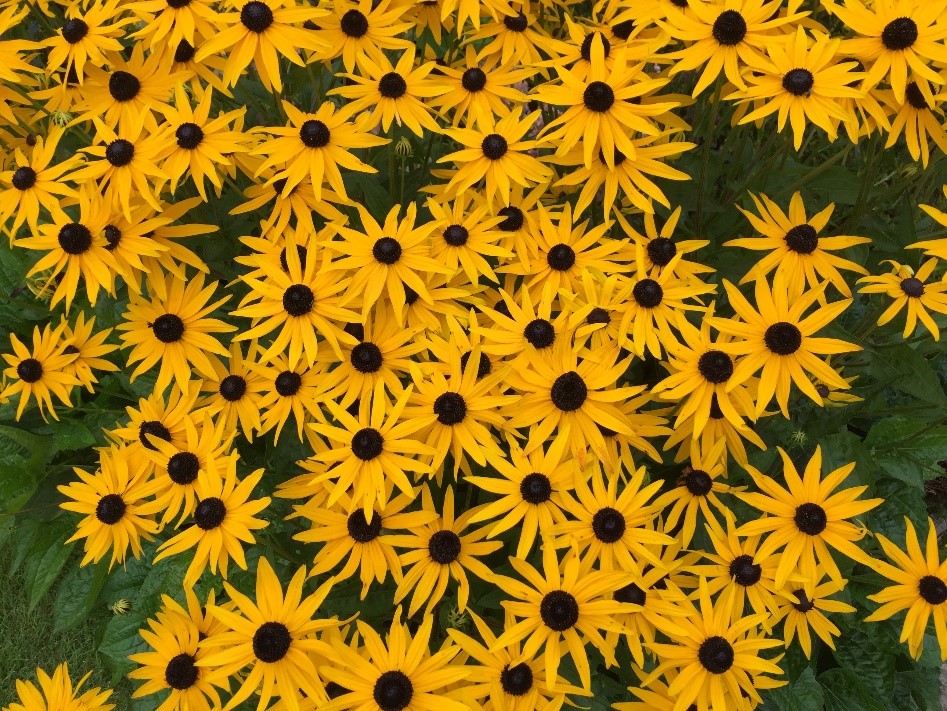 Rudbeckia fulgida ‘Goldsturm’ is a clump forming perennial with dark green ovate leaves. It flowers from July to October and the 9cm yellow daisy like flowers have a cone shaped dark brown centre which attract many bees and butterflies.
Rudbeckia fulgida ‘Goldsturm’ is a clump forming perennial with dark green ovate leaves. It flowers from July to October and the 9cm yellow daisy like flowers have a cone shaped dark brown centre which attract many bees and butterflies.
Grows best in moist but well drained soil in full sun but will stand partial shade reaching a height of 60 cm.
Propagation is by division in spring or autumn and plants are generally disease free. They are compact perennials which are easy to grow and produce excellent cut flowers.
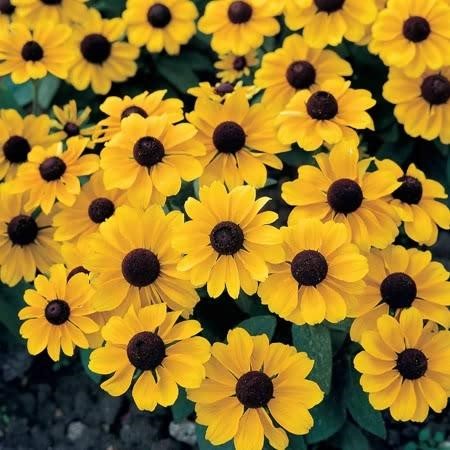 Rudbeckia ‘Toto’ is an easy to grow trouble free annual raised from seed and produces masses of 9cm golden yellow flowers. Growing to 30cm in height this long flowering annual can be used in borders or planted in containers on the patio. The flowers attract bees and other pollinating insects.
Rudbeckia ‘Toto’ is an easy to grow trouble free annual raised from seed and produces masses of 9cm golden yellow flowers. Growing to 30cm in height this long flowering annual can be used in borders or planted in containers on the patio. The flowers attract bees and other pollinating insects.
August
Joe Pye Weed (Eupatorium maculatum atropurpureum)
Eupatorium is commonly known as Joe Pye Weed. They are strong growing perennials which can reach a height of 1.8 metres and are good for planting at the back of borders. The plants produce large domed panicles of pinkish-purple nectar rich flowers, made up of numerous small flowers rich in nectar and pollen.
Plants can be cut back and given the ‘Chelsea Chop’ in May which encourages the plant to produce many more flowering shoots. By doing this the overall height of the plant is reduced slightly and it encourages the plant to produce many more flowering shoots but the flowers are slightly smaller.
Honey, bumble, solitary bees, butterflies, moths and hoverflies visit the flowers for the nectar and pollen which is produced from late July into the autumn.
It is a low maintenance trouble free plant and performs best in full sun or partial shade and is useful for planting in damp areas near ponds and streams.
It is recommended to lift and divide every 3 to 4 years and is said to be resistant to deer and rabbit.
June
Lavender (Lavandula angustifolia)
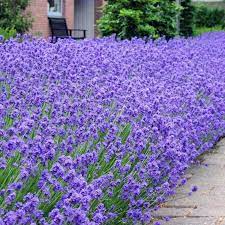 There are about 47 known species of lavender which are in the mint family Lamiaceae. The image is of Lavandula angustifolia ‘Munstead’ and along with ‘Hidcote’ is a compact form of English lavender. They produce masses of deep purple-blue flowers and are one of the finest varieties available and a perfect choice for creating a lavender hedge.
There are about 47 known species of lavender which are in the mint family Lamiaceae. The image is of Lavandula angustifolia ‘Munstead’ and along with ‘Hidcote’ is a compact form of English lavender. They produce masses of deep purple-blue flowers and are one of the finest varieties available and a perfect choice for creating a lavender hedge.
Lavender is attractive to many beneficial insects including our honeybees, bumblebees and butterflies. Lavender flowers from June to August, nectar is produced freely and the honey produced is of a dark colour which sets with a smooth, fine grain. Plants need to be grown in full sun on light well drained, chalky soils as they do not like damp conditions.
Lavenders can become woody and untidy and the plants need an annual trim after flowering has finished to keep them compact and attractive. They do not produce new growth easily from old stems so care must be taken when carrying out any annual pruning and I would suggest replacing any old plants with new.
May
Hawthorn (Crataegus monogyna)
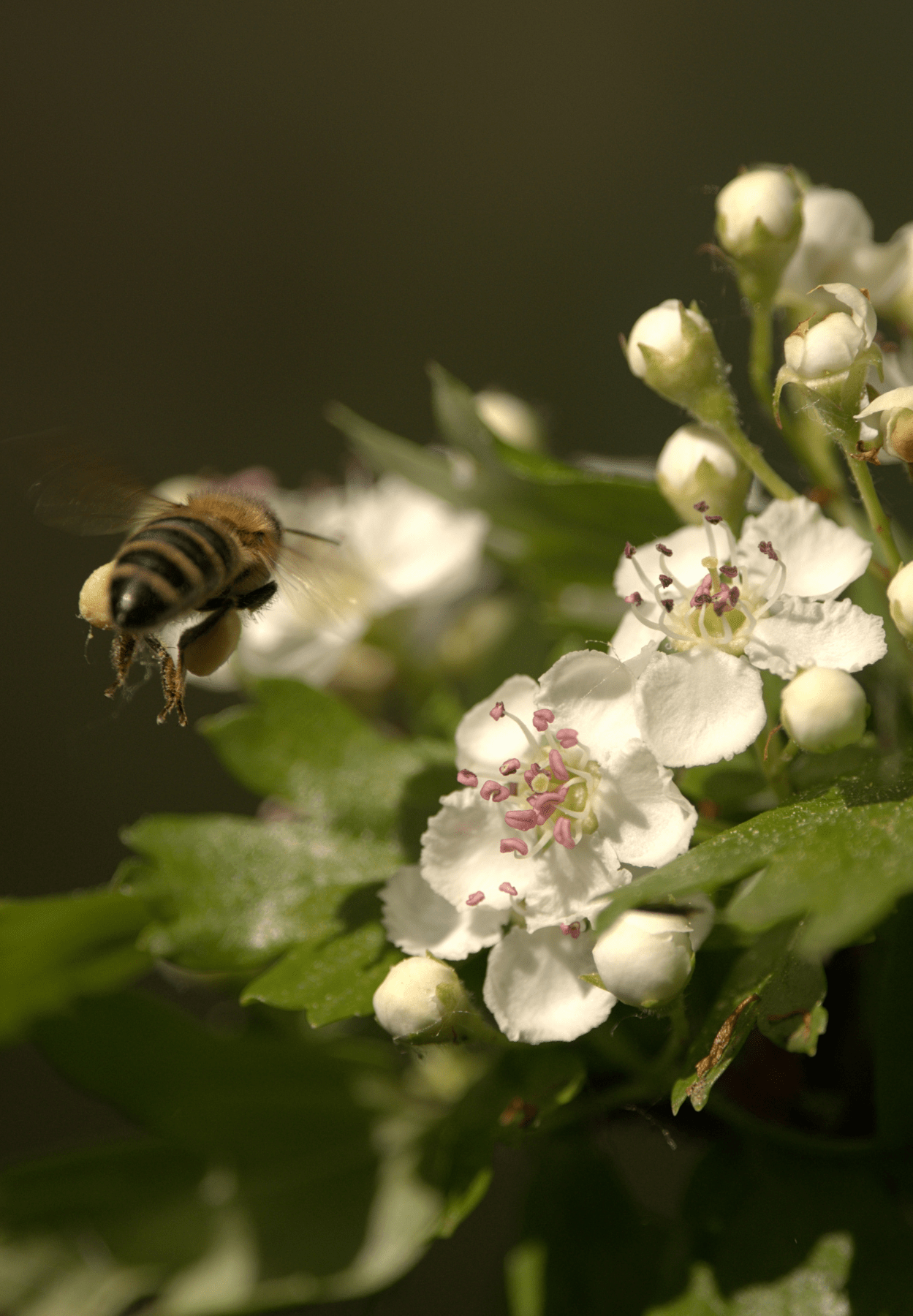 The hawthorn is a well-known common shrub or small tree found all over the British Isles which is used as a farm hedge and tolerates a wide range of soils and weather conditions. There are two native species of hawthorn and the difference between them is slight. The midland hawthorn (Crataegus laevigata) is found more to the southeast of Britain. Hawthorn is an intermittent provider of honey and is said to produce only once every five or six years when the weather is fine and humid. The small white blossoms are visited by honey, bumble and solitary bees for nectar and pollen.
The hawthorn is a well-known common shrub or small tree found all over the British Isles which is used as a farm hedge and tolerates a wide range of soils and weather conditions. There are two native species of hawthorn and the difference between them is slight. The midland hawthorn (Crataegus laevigata) is found more to the southeast of Britain. Hawthorn is an intermittent provider of honey and is said to produce only once every five or six years when the weather is fine and humid. The small white blossoms are visited by honey, bumble and solitary bees for nectar and pollen.
A more reliable thorn is the Cockspur Thorn (Crataegus prunifolia) which has slightly larger white flowers and gives three seasons of interest which makes it a great plant for many locations. It has oval glossy green leaves with a toothed margin which changes to a combination of yellow, orange and red in the autumn with plump red berries which provide a feast for the birds and are soon devoured.
Crataegus prunifolia is not demanding and is a good choice for urban planting as it tolerates most soils, pollution, heat and wind.
April
Darwin’s barberry (Berberis darwinii)
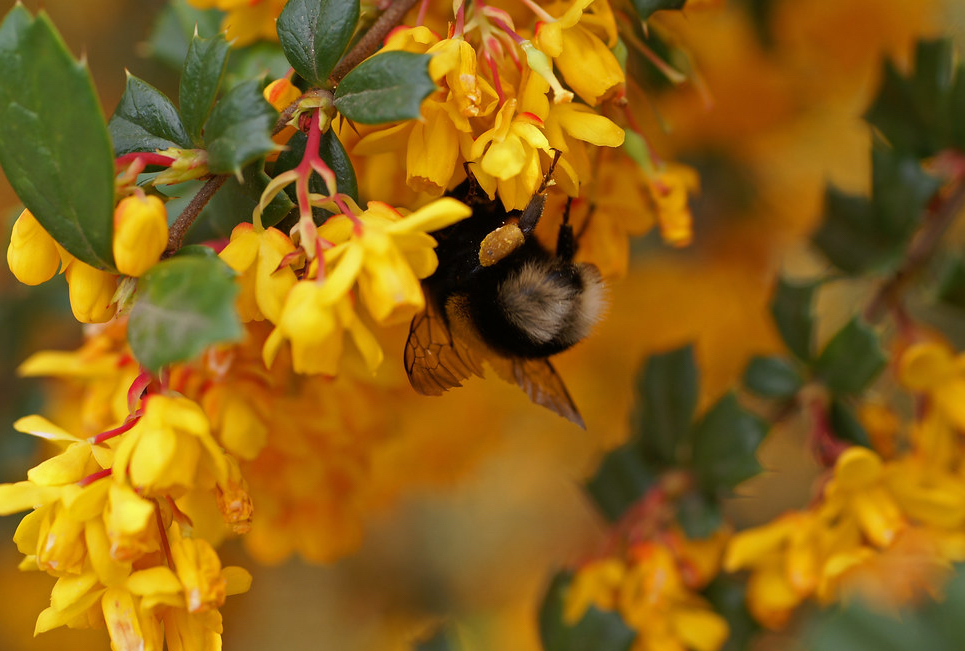 Berberis darwinii is an evergreen flowering shrub reaching 1.8 metres in height after about 10 years. It has a mass of deep orange flowers which are visited for both nectar and pollen. In early spring it is useful to bumblebee queens feeding to build up their own energy and provide food stores to raise the first workers to establish their colonies.
Berberis darwinii is an evergreen flowering shrub reaching 1.8 metres in height after about 10 years. It has a mass of deep orange flowers which are visited for both nectar and pollen. In early spring it is useful to bumblebee queens feeding to build up their own energy and provide food stores to raise the first workers to establish their colonies.
There are many evergreen and deciduous varieties of Berberis which flower from late March with Berberis darwinii and continue through until late July with Berberis wilsonae which has coral red berries during winter. They are not favoured by many gardeners due to the spiny leaves and branches but bees visit them in abundance when in flower.
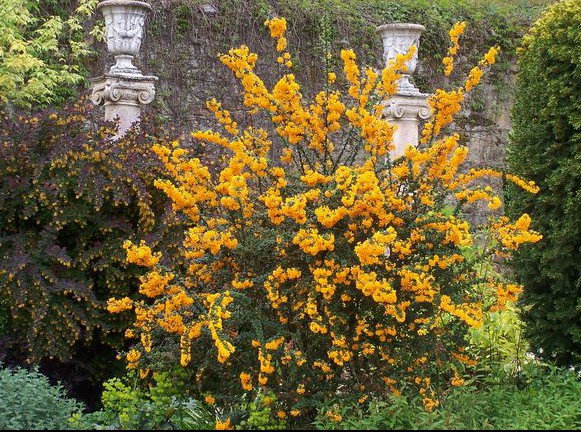
Berberis tolerate a wide range of soils and grow happily in shade or full sun. Any pruning can be carried out immediately after flowering except for Berberis wilsonae which is best pruned in the early part of the year and will flower on the new growth in July.
March
Winter Aconite (Eranthis hyemalis)
Eranthis is a tuberous rooted woodland plant with bright golden yellow buttercup – like flowers surrounded by divided leafy bracts. It can be seen in flower as early as January in mild winters and depending on area flowering extends to March. Honeybees visit Eranthis for nectar and pollen on warm days but the flowers are probably open too early for many bumblebees except for winter active buff-tailed bumblebees.
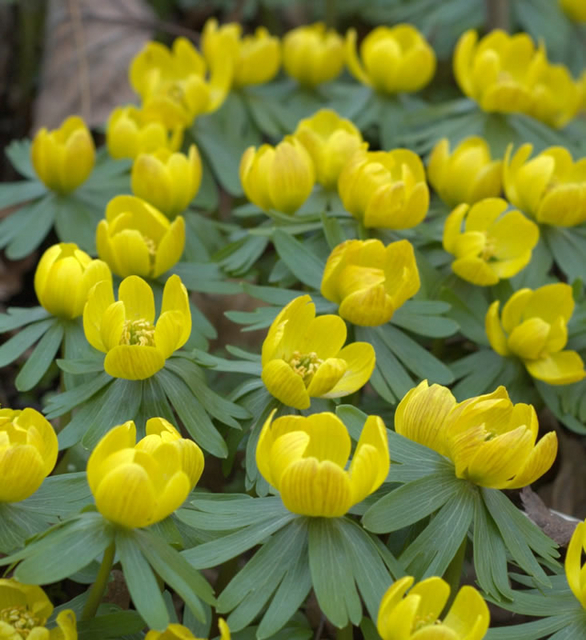 It is a good ground cover plant which quickly spreads and is perfect for planting beneath trees or naturalising in grass around beehives, like Crocus.
It is a good ground cover plant which quickly spreads and is perfect for planting beneath trees or naturalising in grass around beehives, like Crocus.
Tubers can be bought in the autumn but are said not to be as successful as plants bought in the green. Eranthis will grow in most soils but does prefer alkaline soils.
February
Crocus species
Crocus produce large amounts of pollen and depending on the season and location can flower as early as February in mild areas. Bees prefer fresh pollen to stored pollen and fresh pollen is said to have a higher nutritional value to stored pollen. The Crocus is one of the earliest plants to flower and on warm days honeybees, early bumble bees and some solitary bees can be seen foraging for the bright orange pollen. Pollen is necessary for proper post-emergence glandular development and growth of internal structures during the first 8-10 days of a worker’s life. The nectar produced at the base of the flower is only accessible to long tongued bees and both pollen and nectar come at a time when colonies are building up ready for the main flowering season.
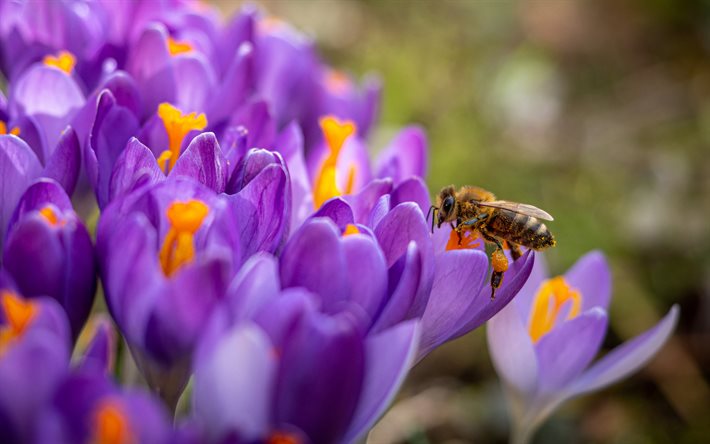
Plant crocus corms in autumn in well-drained soil in full sun about 3” deep. If planted in grassed areas for naturalising leave for about 6 weeks until the flowers and leaves have faded before mowing.
Crocus are ideal for planting in pots but require covering with netting to protect them from mice and squirrels.
The Saffron crocus (Crocus sativus), which flowers in the autumn, produces pale blue flowers with a bright red 3 branched style which are collected and used as a spice in cooking. It takes about 150 flowers to produce 1 gram of Saffron.
January
Winter Honeysuckle (Lonicera fragrantissima)
 The winter flowering honeysuckle flowers on almost leafless branches between late December to March depending on its planting site and can attain a hight of 2 metres and a width of 2.5 metres. It will grow in any moist well drained fertile soil but grows best and flowers more profusely when planted in an alkaline soil against a wall. Planting against a wall gives the delicate fragrant creamy white flowers some protection against any winter frost and on mild winter days the flowers are visited by honeybees and any early flying bumblebees.
The winter flowering honeysuckle flowers on almost leafless branches between late December to March depending on its planting site and can attain a hight of 2 metres and a width of 2.5 metres. It will grow in any moist well drained fertile soil but grows best and flowers more profusely when planted in an alkaline soil against a wall. Planting against a wall gives the delicate fragrant creamy white flowers some protection against any winter frost and on mild winter days the flowers are visited by honeybees and any early flying bumblebees.
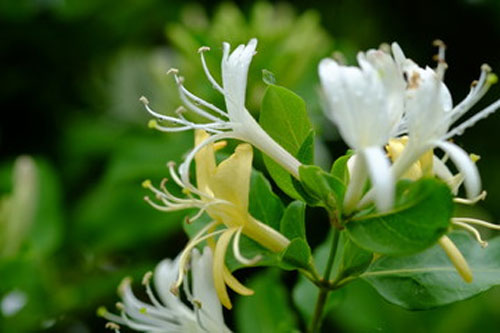
It can be propagated by softwood cuttings in summer or hardwood cuttings in the autumn.
Any pruning is best carried out in late spring following flowering by removing the older weaker wood at the base of the shrub to encourage new growth from the base.
November
All the single flowering species of Dahlia supply nectar and pollen to the bees from July until the first frosts, which may be in November/December. They are long flowering and easy to grow and flourish in any well drained moist fertile soil. There are many varieties and colours which range from the small mixed single bedding varieties grown from seed to the larger varieties such as the Bishop of Llandaff pictured.
In the past it has always been best practice to lift dahlia tubers to prevent them being frosted. With weather patterns changing many gardeners leave the tubers in the ground and give them a good mulch of well-rotted garden compost to protect them from any harsh frosty weather we may have.
If you decide to lift tubers for the winter make sure they are allowed to dry out. Turning the tubers upside down for a few weeks helps the hollow stems to drain before placing them in a frost-free place for the winter.
Start tubers into growth in early spring Feb/March in a shallow tray of compost. When shoots are about 3 – 4 cm tall, tubers can be divided making sure each section has both roots and shoots before potting up and growing on ready for planting out in May/June.
Another method of increase is to take softwood cuttings from the early growth produced in spring. Place cutting in a 50/50 peat and perlite compost which at this time of year will root very quickly.
Another way is to grow bedding Dahlia from seed.
October
Verbena bonariensis
There are about 250 species of annual and perennial verbena.
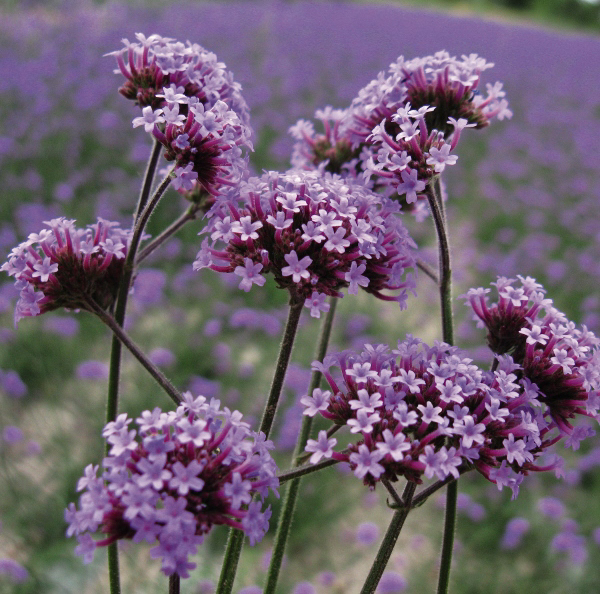 Verbena bonariensis and other varieties such as hastata, stricta, and rigida are all worked for nectar and pollen by honeybees, bumblebees, butterflies, hoverflies and moths. V. bonariensis can reach 1.8 metres in height with purple blue flowers from mid-July until late October supplying nectar and pollen to many insects. Another variety of V. bonariensis is ‘Lollipop’ which is lower growing and reaching 45cm in height.
Verbena bonariensis and other varieties such as hastata, stricta, and rigida are all worked for nectar and pollen by honeybees, bumblebees, butterflies, hoverflies and moths. V. bonariensis can reach 1.8 metres in height with purple blue flowers from mid-July until late October supplying nectar and pollen to many insects. Another variety of V. bonariensis is ‘Lollipop’ which is lower growing and reaching 45cm in height.
The only wild Verbena of the British Isles is Verbena officinalis which has a long history of use for medicinal purposes such as anti-inflammatory, anti-bacterial, antispasmodic and analgesic properties.
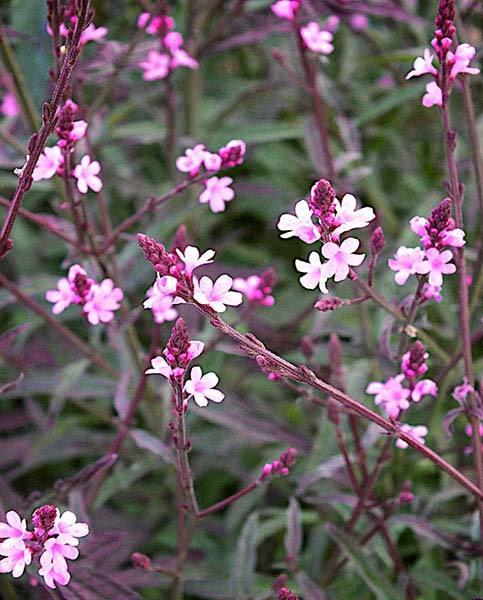 Verbena officinalis ‘Bampton’ is another good bee plant which has purple green foliage and spikes of pink flowers. It was bred from a cultivar found growing in the town of Bampton, Devon and grows to about 80cm. Leave the old seed heads on for winter interest, then cut right back in spring as the new shoots are appearing.
Verbena officinalis ‘Bampton’ is another good bee plant which has purple green foliage and spikes of pink flowers. It was bred from a cultivar found growing in the town of Bampton, Devon and grows to about 80cm. Leave the old seed heads on for winter interest, then cut right back in spring as the new shoots are appearing.
Verbena’s prefer a moist well drained soil in a sunny sheltered position and may need protection during cold winters to survive. Leaving the dead stems on over winter will protect the crown of the plant and also applying a mulch of compost or straw. In ideal growing conditions they will self-seed but can become invasive.
September
Helenium (Sneezeweed)
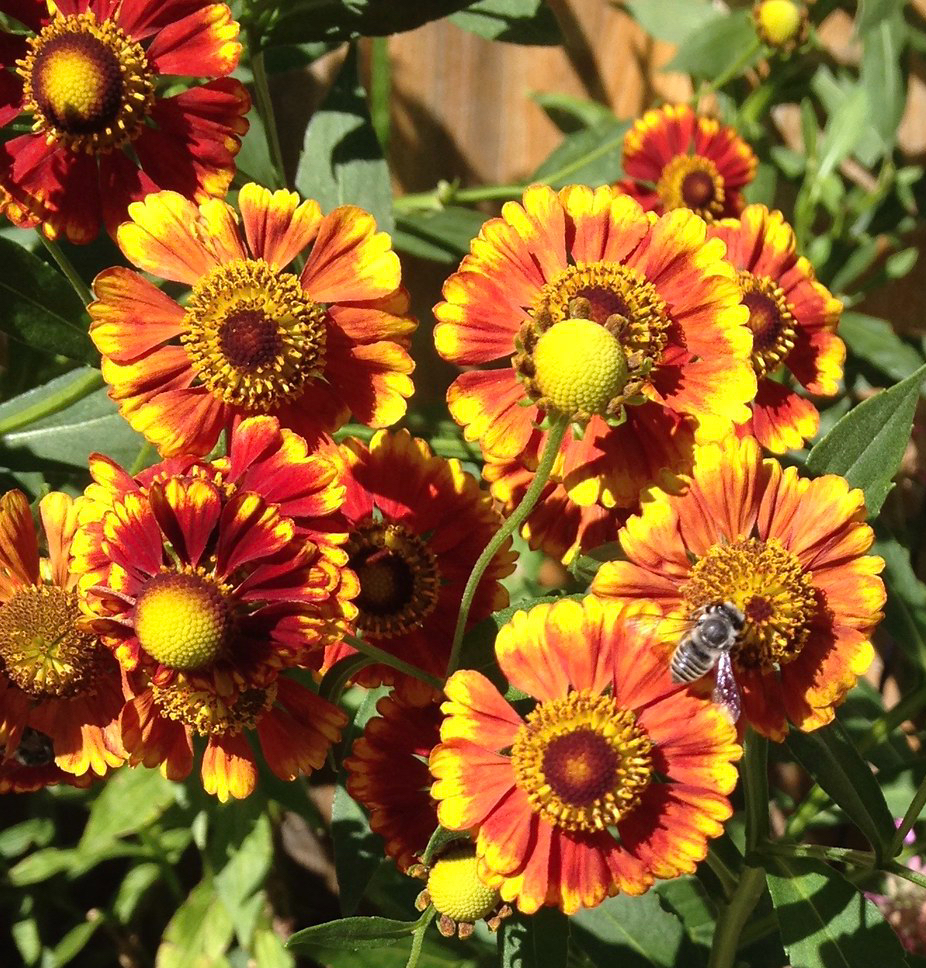 Helenium’s are clump forming annuals, biennials and perennials from Central and North America. Sneezeweeds flower over long periods and can be seen in flower from mid July until the end of September. Earlier flowering varieties can be encouraged to flower again by dead heading. The flowers are daisy-like with prominent discs of yellow or brown, and ray florets of yellow, orange and red and provide a valuable late source of nectar and pollen for bees and butterflies.
Helenium’s are clump forming annuals, biennials and perennials from Central and North America. Sneezeweeds flower over long periods and can be seen in flower from mid July until the end of September. Earlier flowering varieties can be encouraged to flower again by dead heading. The flowers are daisy-like with prominent discs of yellow or brown, and ray florets of yellow, orange and red and provide a valuable late source of nectar and pollen for bees and butterflies.
Helenium’s are happy in most fertile, but well drained soil in sun or partial shade. It is a good idea to dig up the plants every 3-4 years and divide using the outer younger shoots as older plants can become starved and bedraggled. This operation is best carried out in spring after enriching the soil with compost.
August
Ling Heather (Calluna Vulgaris)
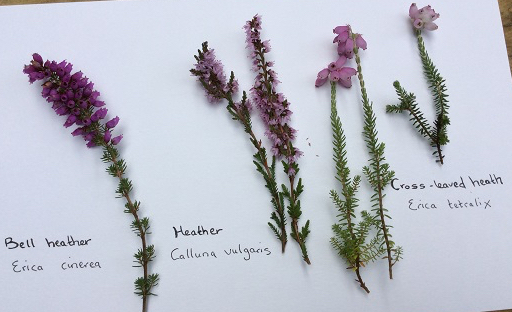 Ling heather comes into flower from about mid-August and continues flowering until the end of September. It requires an acid soil to flourish as it does not thrive on alkaline soils. Honeybees, bumble and solitary bees all forage for nectar and pollen when the weather is favourable but it is said that a really good year from heather only occurs about one year in seven. Heather honey is thixotropic and has a gelatinous nature which means it cannot be extracted by ordinary extractors and has to be pressed out of the comb. The colour of the honey is reddish brown with many air bubbles due to the pressing process but becomes liquid when stirred. Heather honey has a strong flavour and higher protein content, approx 1.8-2%, whereas floral honey has a protein content of 0.2%. The water content of heather honey is also different, being up to 23% for heather but only 17-20% for floral honey.
Ling heather comes into flower from about mid-August and continues flowering until the end of September. It requires an acid soil to flourish as it does not thrive on alkaline soils. Honeybees, bumble and solitary bees all forage for nectar and pollen when the weather is favourable but it is said that a really good year from heather only occurs about one year in seven. Heather honey is thixotropic and has a gelatinous nature which means it cannot be extracted by ordinary extractors and has to be pressed out of the comb. The colour of the honey is reddish brown with many air bubbles due to the pressing process but becomes liquid when stirred. Heather honey has a strong flavour and higher protein content, approx 1.8-2%, whereas floral honey has a protein content of 0.2%. The water content of heather honey is also different, being up to 23% for heather but only 17-20% for floral honey.
Two other heathers that flower during the summer and autumn are the cross- leaved heath (Erica tetralix) and the bell heather (Erica cinerea) that also require acid growing conditions.
The Cornish Heath (Erica vagans) flowers at this time but will happily grow in alkaline soils. Honey from these three heathers are not thixotropic and will extract the normal way.
The winter heather (Erica carnea) will also grow happily in alkaline soils.
The following conditions are important in acquiring a good crop from the heather: –
1, A strong healthy disease-free colony headed by a young queen with a brood box full of bees and brood. (Amalgamating two colonies can be a good idea).
2, Young plants secrete more nectar than older plants and colonies sited on grouse moors where the heather is managed to encourage young growth is best.
3, The nature of the soil and rainfall during the growing season prior to flowering is vitally important to develop good young flowering shoots.
4, Good warm weather for foraging by the bees during flowering time as temperatures at altitude can be much lower.
July
Rosebay Willowherb (Chaemerion angustifolium, previously Epilobium angustifolium)
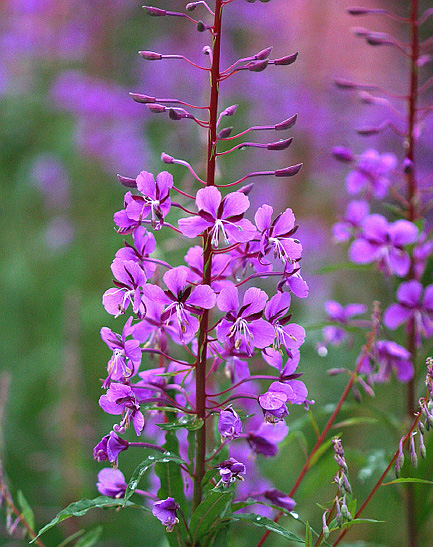 Rosebay Willowherb flowers from late June to August and is classed as a major plant source of nectar and pollen for honeybees, bumblebees and solitary bees. It is a tall herbaceous perennial with a spike of large pink flowers and the pollen is very distinctive being blue/green in colour. Honey produced from Willowherb has no distinct flavour and when crystallised is very pale and sets with a fine grain. The seeds produced are very light and feathery and drift for a long way in the wind. This enables it to quickly colonise areas such as demolition sites, freshly cut forestry sites and it can also found growing along railway embankments and many road side verges. When established it’s creeping underground runners enable it to spread rapidly and it may become a problem in some areas.
Rosebay Willowherb flowers from late June to August and is classed as a major plant source of nectar and pollen for honeybees, bumblebees and solitary bees. It is a tall herbaceous perennial with a spike of large pink flowers and the pollen is very distinctive being blue/green in colour. Honey produced from Willowherb has no distinct flavour and when crystallised is very pale and sets with a fine grain. The seeds produced are very light and feathery and drift for a long way in the wind. This enables it to quickly colonise areas such as demolition sites, freshly cut forestry sites and it can also found growing along railway embankments and many road side verges. When established it’s creeping underground runners enable it to spread rapidly and it may become a problem in some areas.
The plant has a fascinating flowering mechanism to avoid self-pollination. The first flowers to open are at the bottom of the flowering spike and the anthers (male parts) carrying the pollen mature early releasing the pollen and then shrivel before the stigma (female parts) are mature. The transfer of pollen from the younger flowers higher up the flower spike to older flowers with ripe stigmas lower down is reduced by the plant producing more nectar from flowers at this ‘female’ stage. This plant mechanism is called protandry whereas protogyny is where the stigmas mature first.
June
Lime or Linden (Tilia platyphyllos – Large leaved lime, Tilia cordata – Small leaved lime and Tilia x europaea – Common lime)
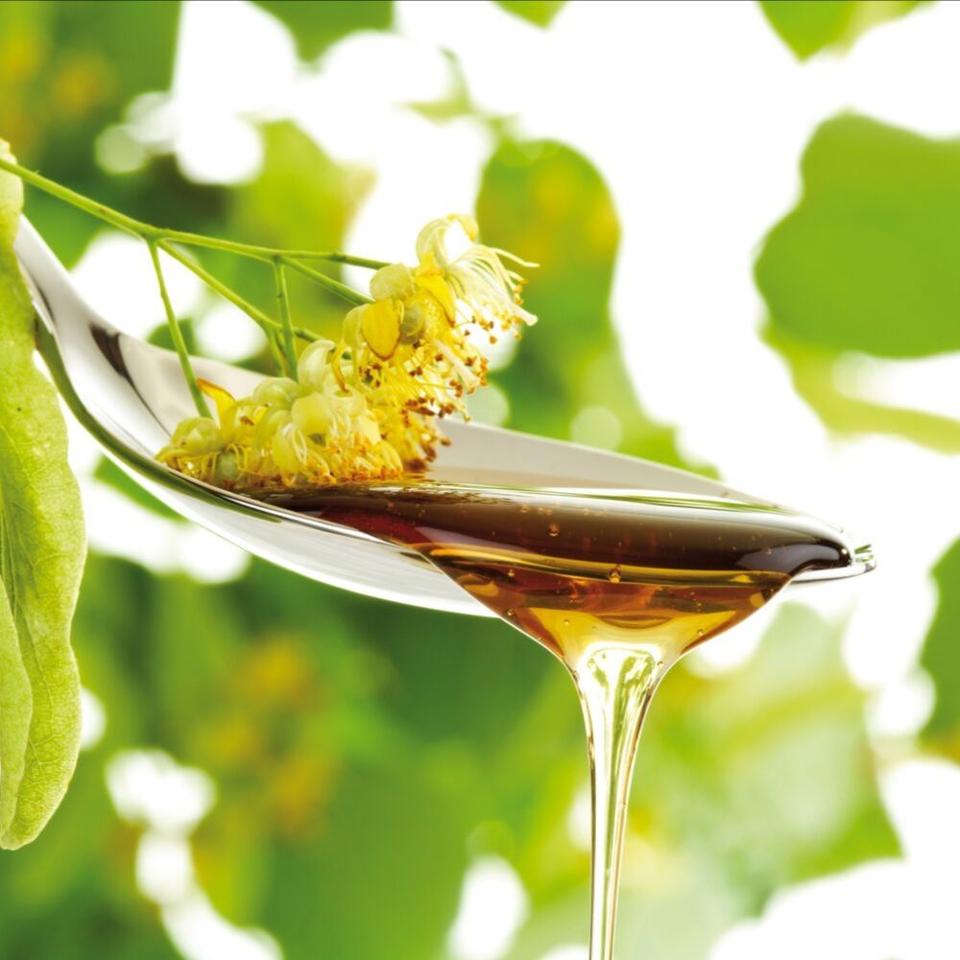 Lime trees are considered one of the major nectar sources for bees. Lime produces large volumes of nectar mainly in the morning before midday with the optimum temperature for secretion being about 20°C. Lime honey is said to be one of the most distinctive with a pleasant minty flavour and is light amber in colour with a greenish tinge. Flowers last for about 2-3 weeks and depending on site, soil, situation and species the flowering time can differ over several days, prolonging the length of foraging for our bees.
Lime trees are considered one of the major nectar sources for bees. Lime produces large volumes of nectar mainly in the morning before midday with the optimum temperature for secretion being about 20°C. Lime honey is said to be one of the most distinctive with a pleasant minty flavour and is light amber in colour with a greenish tinge. Flowers last for about 2-3 weeks and depending on site, soil, situation and species the flowering time can differ over several days, prolonging the length of foraging for our bees.
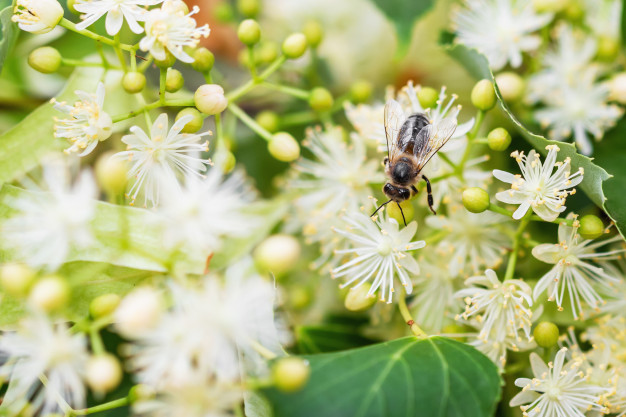 There are three limes which are native to the British Isles, Tilia platyphyllos (Large leaved lime), Tilia cordata (Small leaved lime) and Tilia x europaea (Common lime).
There are three limes which are native to the British Isles, Tilia platyphyllos (Large leaved lime), Tilia cordata (Small leaved lime) and Tilia x europaea (Common lime).
The common lime and large leaved lime are the worst offenders for honeydew which is the sugary solution excreted by aphids.
Large numbers of dead and dying bees can sometimes be found beneath some species of late flowering lime especially Tilia ‘Petiolaris’, Tilia tomentosa and Tilia ‘Orbicularis’. Research in the 1970’s suggested that the nectar was unusually high in a sugar called mannose. Bumblebees and honeybees are unable to digest it adequately because they have low levels of an enzyme that is important for the process. However, research in Germany in the 1900s and 2000s by Thomas Baal and others has contradicted this. No evidence was found for mannose in the nectar from trees with dead bees beneath them. Bees were most affected at the end of the lime flowering period or in dry years when there was very little nectar in the flowers. When bees below a tree were fed with nectar from the same tree, they were able to recover, so there was no evidence for toxic nectar.
Instead, the evidence indicated that bees were starving or running out of nectar and unable to fly back to their nest.
May
Apple (Malus domestica)
The apple is considered by beekeepers to be the best fruit tree as a source of nectar and pollen for bees. It is grown widely in gardens and parks and flowers over a long period from late April into May due to the many cultivars and varieties grown and is the last of the fruit trees to flower. Apple flowers have an open structure and nectar can be diluted or washed out by rain. This may be why bees can be seen foraging for pollen in the early part of the day and nectar later when the sugar concentration has increased due to evaporation and further nectar secretion by the flowers.
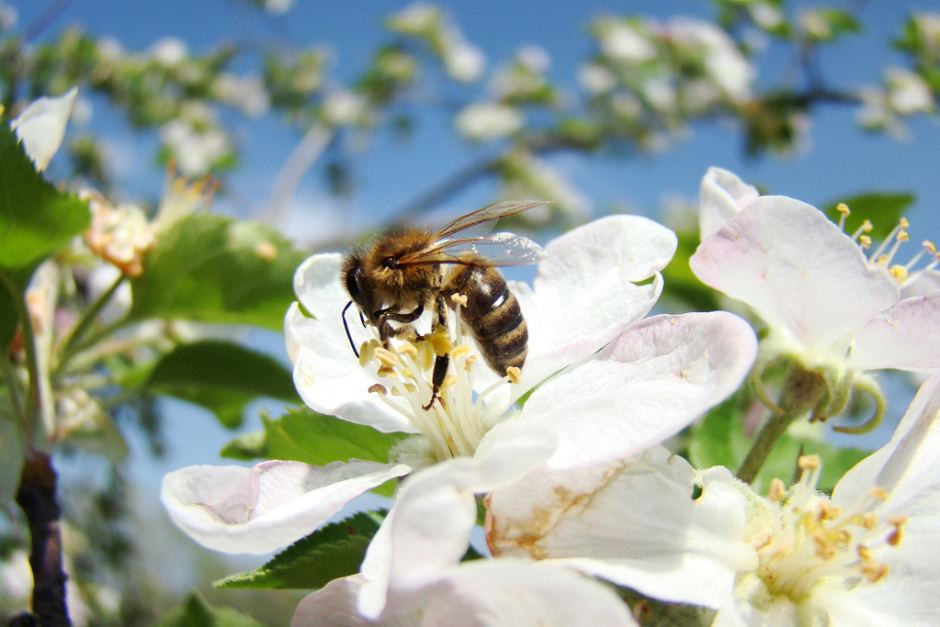 Daily nectar production between varieties of apple vary from 1.8 – 6.2mg of sucrose per flower.
Daily nectar production between varieties of apple vary from 1.8 – 6.2mg of sucrose per flower.
A few apples are self-sterile but the majority require pollen from a different cultivar that flowers at the same time. Even those that are self-sterile fruit better in the presence of a pollinator.
Apple trees are sold as cordon, espalier, fan, bush, half standard or standard, so plenty of choice for either the large or small garden.
April
Norway Maple (Acer platanoides)
The Norway maple is a fairly fast-growing deciduous tree which can be seen all around the country side and in parks and large gardens. It reaches 25 – 30 metres in height and can be mistaken for the Sycamore but does not suffer from aphids. It has attractive greenish yellow flowers that appear on the bare stems well before the leaves, which appear about two weeks later, and it is an unmistakable tree to identify when seen in the countryside. The leaves are more brightly coloured than Sycamore and turn golden – yellow in the autumn. Some cultivars which can be seen growing in urban gardens are: Acer platanoides ‘Crimson King’ with purple foliage which turns bright red in the autumn, ‘Drummondii’ with variegated foliage, and ‘Columnare’ which has narrow upright growth.
All maples are good bee plants and supply nectar and pollen at an essential time for our colonies when building up for the summer. The open nature of the flowers enables honeybees, bumblebees and solitary bees to have easy access to the nectar.
March
Blackthorn (Prunus spinosa)
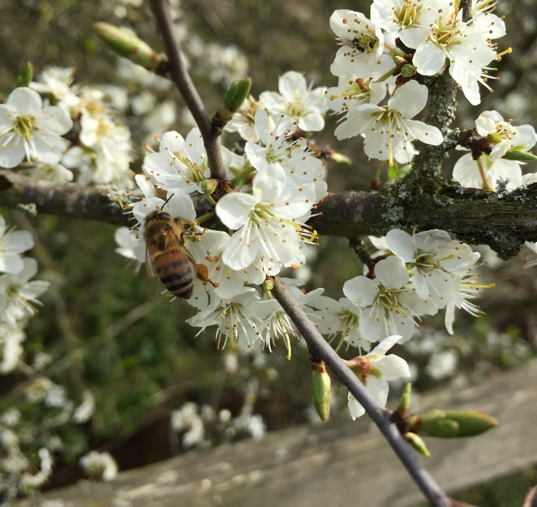 The blackthorn can be found at the edge of woodlands, in field hedgerows and reproduces naturally from its suckering growth and by the distribution of seeds by birds. The snowy white blossoms of blackthorn appear in February/March and contrast well with the black thorny leafless branches. It is not fussy about shelter and will grow on exposed sites and is often mixed with hawthorn when planting new hedges in rural areas thereby providing food and shelter for wildlife. The flowers are a good source of nectar and pollen which bees will take advantage of if the weather is favourable. The flowering season can at times be too early for honeybees to benefit from it but it can be visited by short tongued bumble bees and solitary bees such as the Tawny Mining Bee (Andrena fulva).
The blackthorn can be found at the edge of woodlands, in field hedgerows and reproduces naturally from its suckering growth and by the distribution of seeds by birds. The snowy white blossoms of blackthorn appear in February/March and contrast well with the black thorny leafless branches. It is not fussy about shelter and will grow on exposed sites and is often mixed with hawthorn when planting new hedges in rural areas thereby providing food and shelter for wildlife. The flowers are a good source of nectar and pollen which bees will take advantage of if the weather is favourable. The flowering season can at times be too early for honeybees to benefit from it but it can be visited by short tongued bumble bees and solitary bees such as the Tawny Mining Bee (Andrena fulva).
Cherry Plum (Prunus cerasifera)
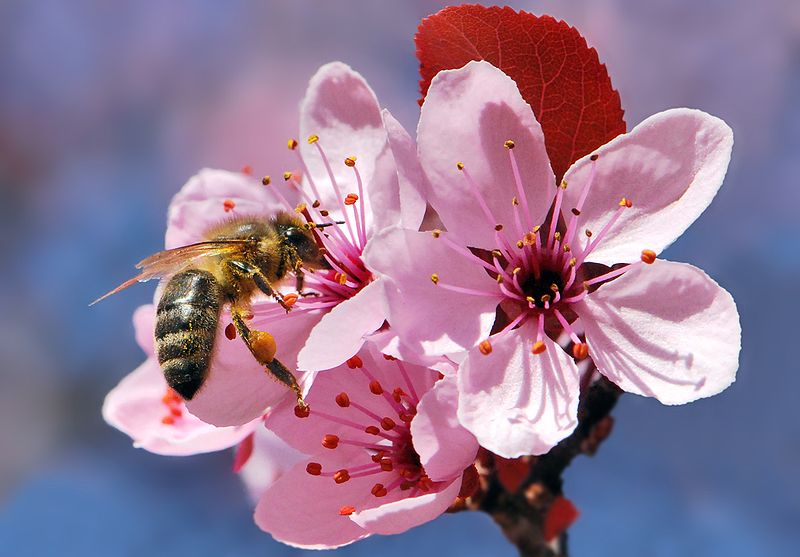 The cherry plum or myrobalan plum flowers around the same time as the blackthorn and can be seen in gardens and is also used in hedge rows. In hedges it is often confused for the blackthorn but the white flowers appear on spineless branches.
The cherry plum or myrobalan plum flowers around the same time as the blackthorn and can be seen in gardens and is also used in hedge rows. In hedges it is often confused for the blackthorn but the white flowers appear on spineless branches.
A common popular cultivar of the cherry plum which is grown for its purple foliage and pink flowers in many gardens and as a street tree is Prunus cerasifera ‘Pissardii’. Both cherry plums are good sources of nectar and pollen for honeybees when the weather is suitable.
February
Hazel (Corylus avellana)
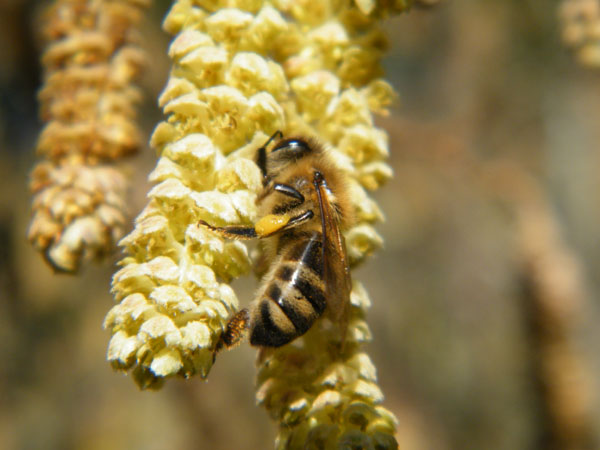
Hazels can be seen in flower from January to March depending on the area andlocationwhere it is growing. The hazel is wind pollinated and clouds of pollen can be seen drifting from the catkins on windy days. It does not need to rely on bees for pollination and fertilisation to produce the nuts. The hazel is common throughout the British Isles and grows best in calcareous soils where in the past it has been grown for coppicing and the stems used for wattle and daub building construction.
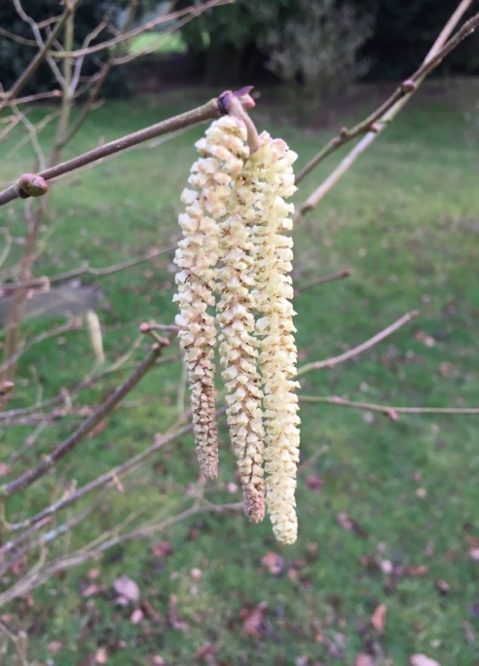
The plants produce no nectar and on warm days the large amounts of powdery pollen are collected by the bees on plants close to the hive. The catkins are available for about a month for thebees to forage on depending on weather and growing conditions. Pollen is vital for expanding colonies at this time of year providing the protein for growth and glandular development.
This is also the perfect time to take some goat willow (salix caprea) cuttings and grow them for future years as they will provide pollen early in the season. 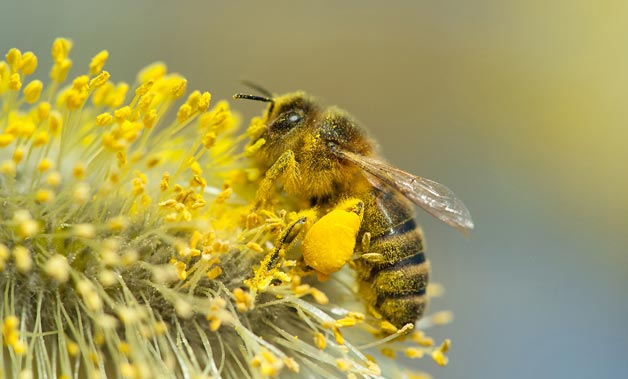
Decembre
Viburnum tinus ( Laurustinus)
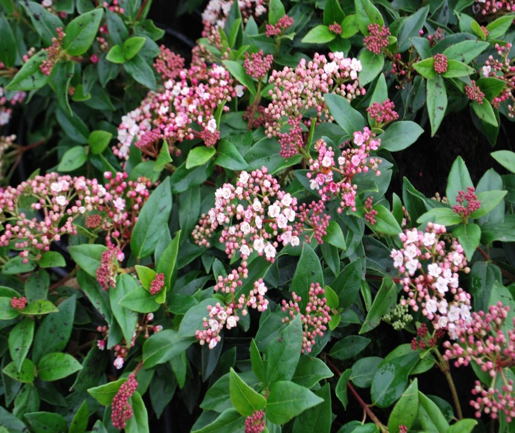 Viburnum tinus is a popular evergreen shrub producing pinkish-white fragrant flowers over a long period from October to April.
Viburnum tinus is a popular evergreen shrub producing pinkish-white fragrant flowers over a long period from October to April.
It is a useful early pollen source for urban beekeepers and on fine warm spring days honeybees and bumble bees may be seen foraging for early pollen. It can be grown in most fertile well drained soil reaching a height of 2.5 metres but needs protection from cold drying winds. It can be used as a hedge or screen but can suffer problems from the Viburnum beetle.
Viburnum tinus responds vigorously to hard pruning and will break out freely even when cut down to the oldest wood near ground level. Shrubs that have been injured by a severe winter may be cut back hard in the same way. This pruning should be carried out in late spring.
October
Phacelia (Phacelia tanacetifolia)
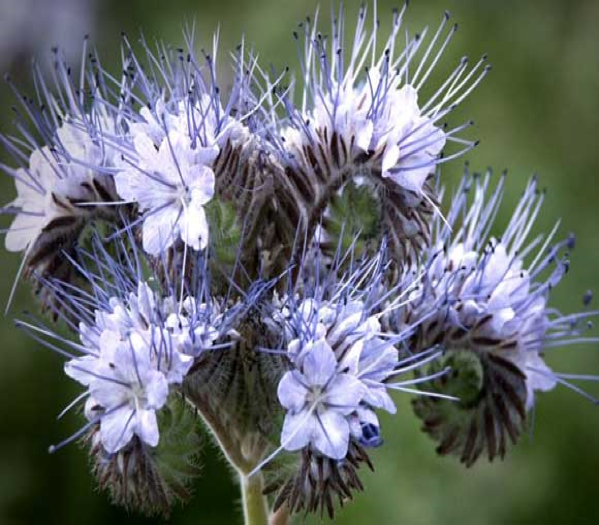 Phacelia flowers are popular with honeybees and short tongued bumblebees and provide large amounts of pollen and nectar. Phacelia is a fast -growing annual flowering from April to November depending on when the seed is sown and with large numbers of flowers produced by each plant. Phacelia is not frost hardy but will survive in mild areas and pollen from its flowers is dark blue.
Phacelia flowers are popular with honeybees and short tongued bumblebees and provide large amounts of pollen and nectar. Phacelia is a fast -growing annual flowering from April to November depending on when the seed is sown and with large numbers of flowers produced by each plant. Phacelia is not frost hardy but will survive in mild areas and pollen from its flowers is dark blue.
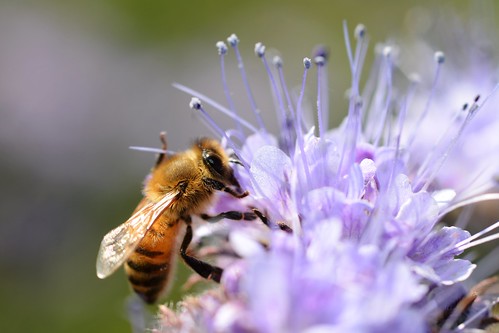
When sown in spring or early summer flowering commences within eight weeks and lasts for 4-6 weeks. Sowing at 4 weekly intervals will give all bees some forage until late in the year.
Phacelia is a good plant for improving soil and is widely grown as a green manure which is dug into the ground before flowering.
September
Stonecrop/Ice Plant (Sedum spectabile)
There are many different forms of Sedum that flower all through the year from ground hugging to 60cm high specimens.

The late flowering Sedum ‘Autumn Joy’ and ‘Brilliant’ with their grey green succulent foliage and flat- topped flowers are the ones which supply our honeybees and Bumblebees with late sources of nectar at a time of year when many other garden species are going over.
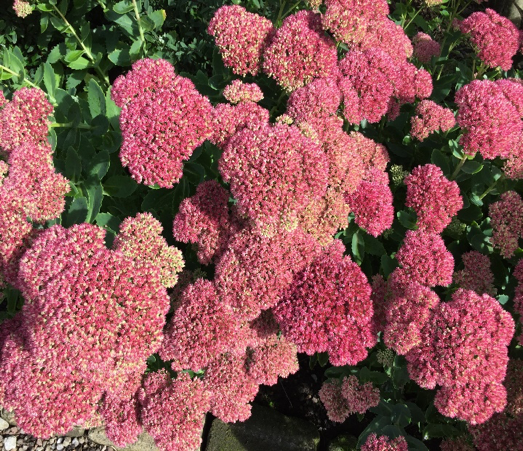 Sedums are easy plants to grow and will grow in most soils but when grown in moist rich ground flowers tend to flop over leaving an open centre. I find when planting them in less fertile ground in full sun the growth is hard and the flowers tend to be more upright and don’t flop over leaving an open centre.
Sedums are easy plants to grow and will grow in most soils but when grown in moist rich ground flowers tend to flop over leaving an open centre. I find when planting them in less fertile ground in full sun the growth is hard and the flowers tend to be more upright and don’t flop over leaving an open centre.
Plants are easy to propagate by dividing in spring.
August
Himalayan balsam (Impatiens glandulifera)
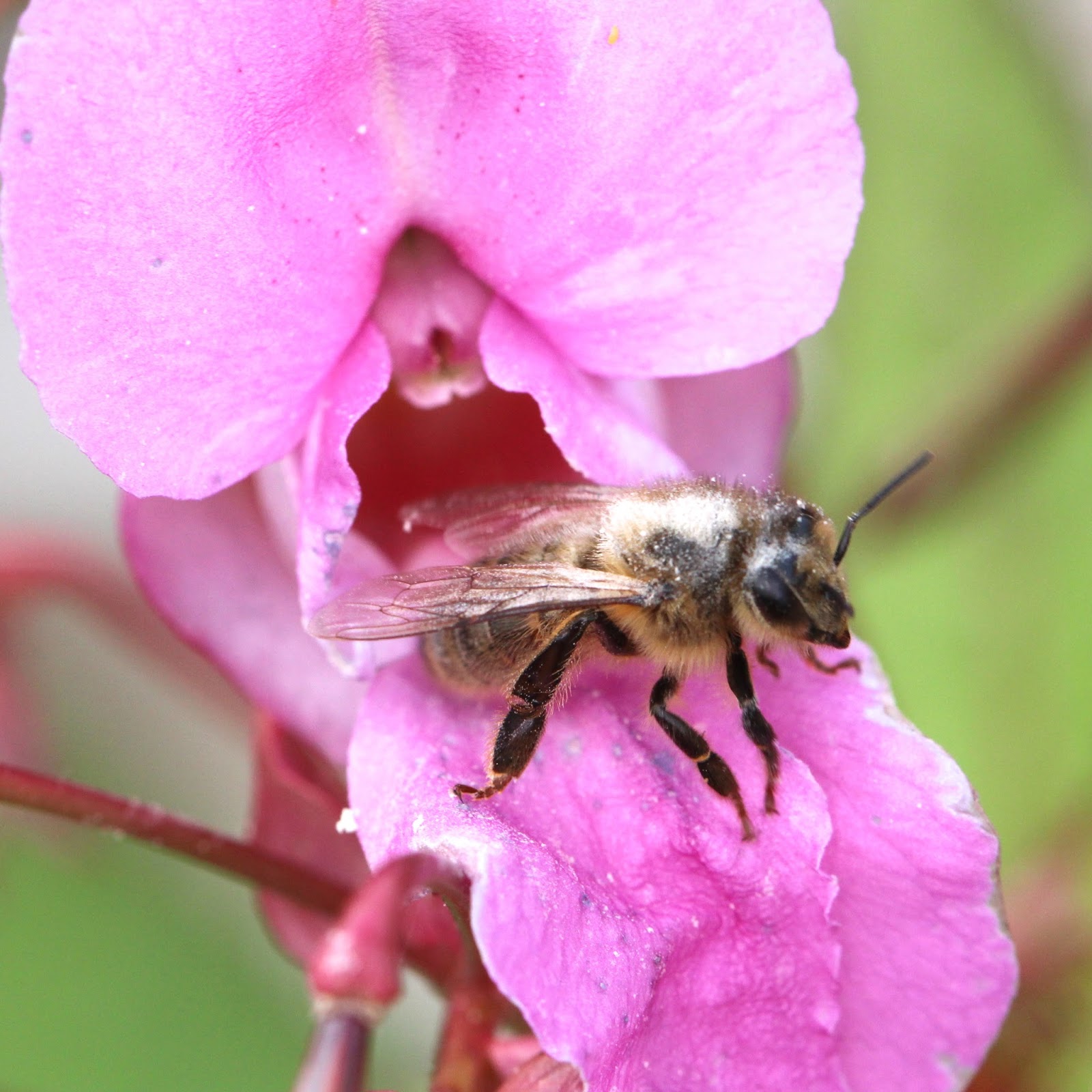
The Himalayan balsam is an invasive non-native species in the UK. The Wildlife and Countryside Act 1981 Order 2010 prohibits planting or causing it to grow in the wild.
It is an introduced plant that first came to England around 1839 when it was grown in greenhouses for its flowers. It escaped into the wild and is now naturalised in most areas of the British Isles and can be seen growing in damp areas and along the banks of many rivers.
The flowers are various shades of pink or white and when the bees enter the flower whitish pollen from the anthers coat the thorax of the bee indicating to the beekeeper where the bees have been foraging and gives the bees the name of ghost bees. Himalayan Balsam flowers July to late into the year and provides the bees with a late source of nectar and honey for bees and beekeeper to harvest.
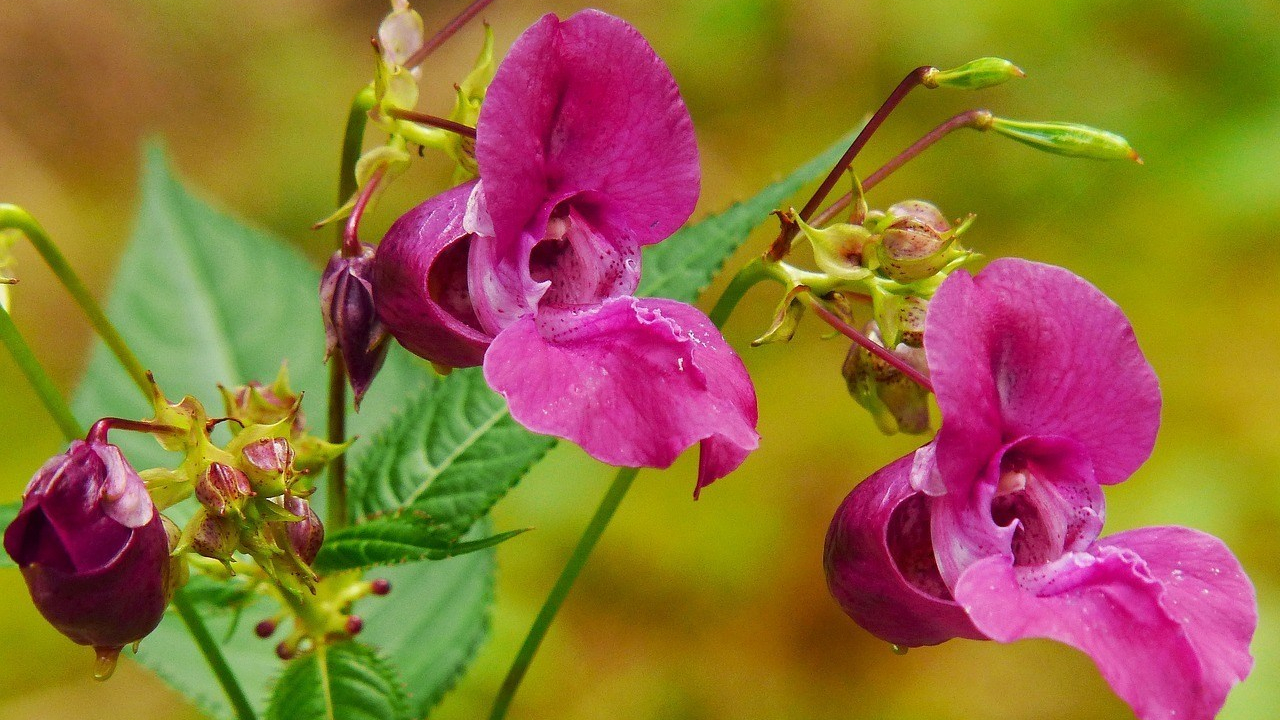 Germination takes place in Feb/March and plants can reach 2mt in height.
Germination takes place in Feb/March and plants can reach 2mt in height.
July
Blackberry (Rubus fruticosus)
The Blackberry is one of the commonest of wild plants and grows in any soil along country lanes, farm land and many gardens.
The flowers are produced on long main stems and short laterals and flowers over a long period between June to October which makes it a valuable plant to ho
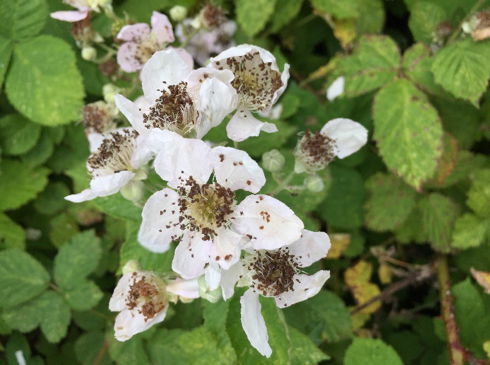
neybees and bumblebees. The flower colour varies from white to light pink although white is the predominant colour.
Plants are deep rooted and drought rarely affects its ability to produce nectar.
Blackberry is a high fructose honey which is slow to granulate and not considered to be the best due to its coarse flavour and large granular structure.
It is attractive to bees and many other pollinating insects for nectar and pollen.
June
White clover (Trifolium repens)
White clover is one of the best plants for bees and produces large amounts of nectar when daytime temperatures favour nectar secretion. It flowers from June to September and each flower consists of 50-100 florets. The florets do not open simultaneously but in a sequence of circles and as the individual florets become pollinated, nectar ceases and the florets wither and droop. Clover grows best on alkaline soils but will tolerate a variety of soils.
Clover has the ability to fix nitrogen from the atmosphere and store it in the root nodules which is released when the plant dies. The nitrogen fixing properties made clover an important agricultural crop as the soil has less need for artificial fertilizers.
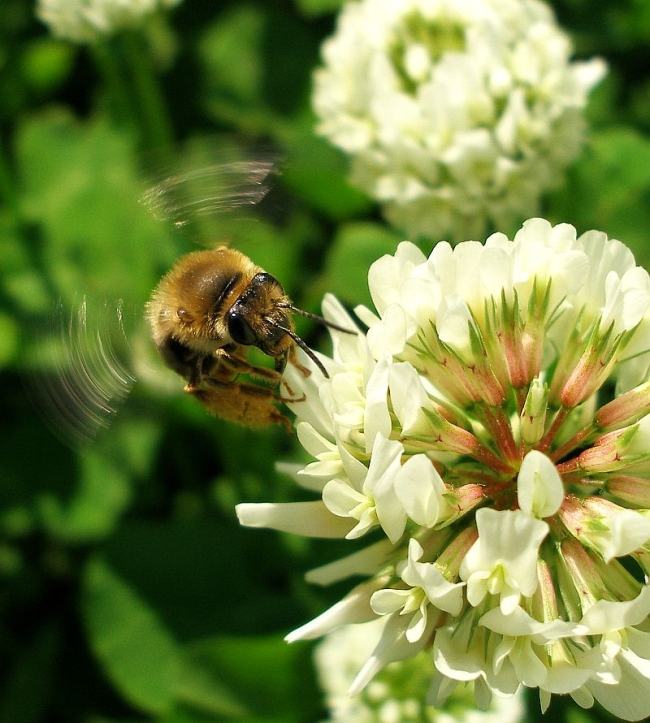 White clover has a shorter flower tube than red clover and the honeybee can easily reach the nectar with their short tongues. Red clover favours bumblebees with long tongues which can reach the nectar at the bottom of the longer flowers which short tongued bees cannot reach.
White clover has a shorter flower tube than red clover and the honeybee can easily reach the nectar with their short tongues. Red clover favours bumblebees with long tongues which can reach the nectar at the bottom of the longer flowers which short tongued bees cannot reach.
May
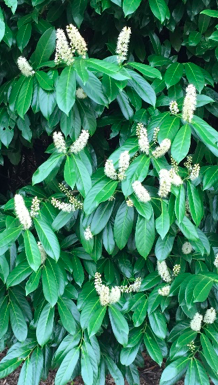 Cherry Laurel (Prunus laurocerasus)
Cherry Laurel (Prunus laurocerasus)
The Cherry laurel and Portugal Laurel both flower between April and May and are attractive to honey and bumble bees for nectar and pollen. They are both common and can be found in many gardens forming shrubs, small trees or used for hedges and screens.
Flowers are produced on the previous years growth so any pruning to keep them tidy is best carried out after flowering has finished and new growth will then be produced to flower the following year. Bees can be seen visiting the plant at other times of year especially when nectar is scarce and can be seen foraging on extra floral nectaries on the underside of the leaf.
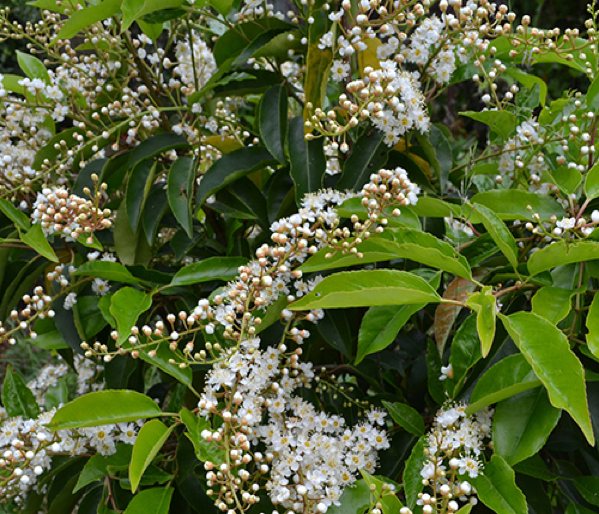
Portugal Laurel (Prunus lusitanica)
The Portugal Laurel is slower growing than the Cherry Laurel and can be used for topiary. It can be trimmed into standards or any shape but if you want it to flower only trim it after flowering. Both plants will tolerate sun or shade and will tolerate most soils.
April
Dandelion (Taraxacum officinale)
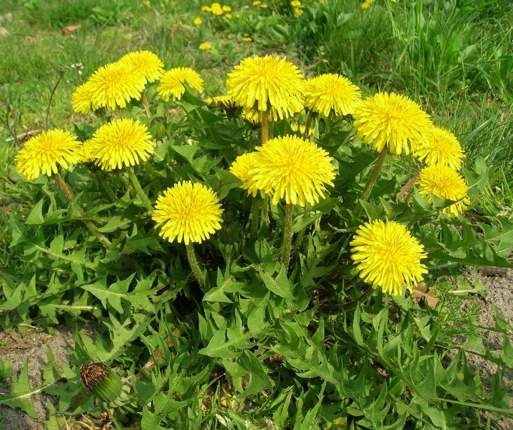
Dandelion flowers most freely early in the year and is a valuable plant to the bees, supplying nectar and pollen at a time when colonies are raising large amounts of brood. The pollen is light yellow and is produced in large amounts but contains low levels of amino acids which are essential for honeybee development. Dandelion pollen grains are oily, light yellow in colour and can appear as a deep orange on the corbicula of the worker bee. Dandelions flowering in orchards where bees are working the apple produce a richer nectar and may detract them from pollinating the fruit.
Flowers close during dull rainy weather which helps protect the nectar and pollen.
Beekeepers can obtain an early crop of honey from the dandelion but the honey is strongly flavoured and crystallises quickly.
March
Pussy Willow, Kilmarnock Willow (Salix caprea)

Willows range from small shrubs to large trees and are an important group providing nectar and pollen for bees. Depending on the variety and favourable weather, nectar and pollen can be available over a few weeks. The most common willow which grows along hedgerows, copses, railway embankments and woods is the Goat Willow. They are not fussy on soil conditions and are easy to grow with the most popular form being the Kilmarnock Willow (Salix caprea pendula) which can be found in garden centres at this time of year. Salix aegyptica is another variety which can flower as early as January and can provide a good source of forage if weather permits. In March pollen is essential for providing the bees with the protein to rear new young bees for the start of the season.
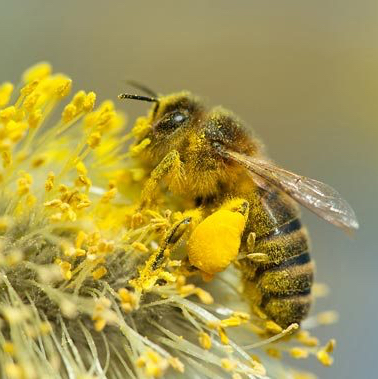
Willow can easily propagated with pencil thickness hardwood cuttings 8-10” long taken at the end of the year and planted close together in a slit trench to two thirds the depth of the stem. When rooted they can be lifted and planted where required.
February
Winter Heather (Erica carnea, Erica x darleyensis)
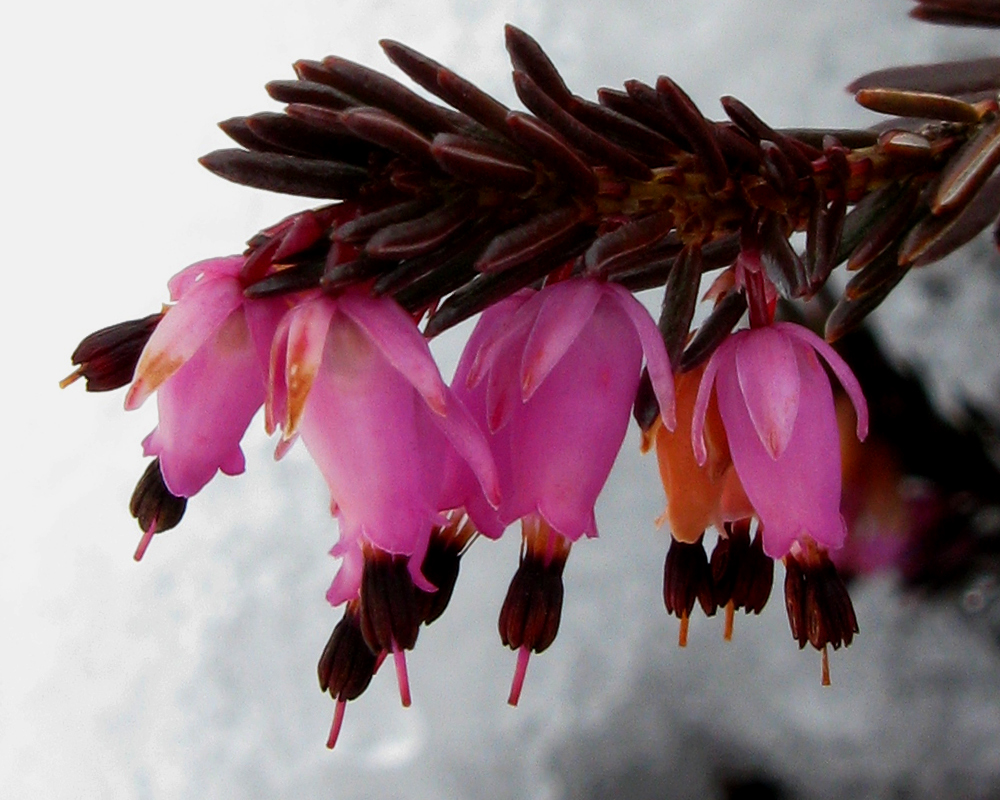
This is probably my favourite plant as it is reliably in flower from as early as late December to early May. Erica carnea and Erica x darleyensis will grow quite happily in alkaline or acid soils and on mild days bees readily visit the flowers mainly for nectar and some pollen. Flower colours vary from white to many shades of pink and red.
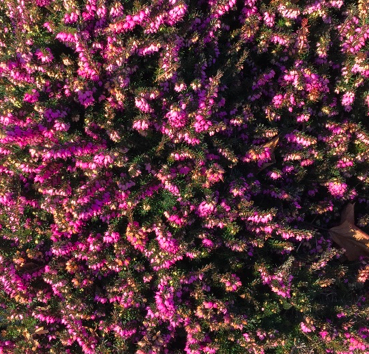
All heathers whether they are summer or winter flowering require some maintenance by cutting the old flower heads back to just below the bottom of the flowers around mid to late April. Following t
his procedure new fresh vigorous shoots will be produced and provide flowers of high quality the following season.
This keeps the plants compact and prevents them becoming straggly. Do not cut back into old wood as heathers will not regenerate.
January
Gorse (Ulex europaeus)
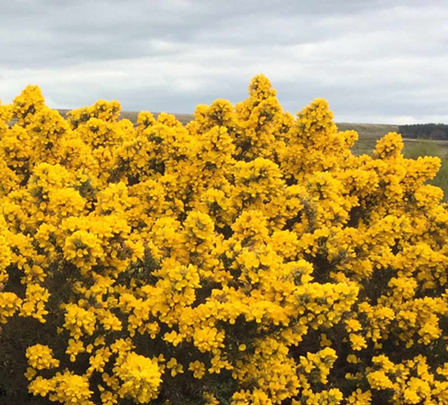 The common gorse is very thorny and not a plant some beekeepers would want to plant in the garden. Can be used for hedging, screens or as a single shrub in the border. Gorse tends to be in flower for most months of the year and is at its best around March/April where it is a good source of pollen for bees, helping colonies build up in spring. Gorse is drought resistant, grows in poor sandy soils and has the ability to fix nitrogen in the soil. It can be seen on many heathland areas where it can become invasive. If grown in rich soils it can become leggy and will need regular pruning to keep it compact.
The common gorse is very thorny and not a plant some beekeepers would want to plant in the garden. Can be used for hedging, screens or as a single shrub in the border. Gorse tends to be in flower for most months of the year and is at its best around March/April where it is a good source of pollen for bees, helping colonies build up in spring. Gorse is drought resistant, grows in poor sandy soils and has the ability to fix nitrogen in the soil. It can be seen on many heathland areas where it can become invasive. If grown in rich soils it can become leggy and will need regular pruning to keep it compact.
It also provides protection, a good nesting habitat and safe haven for breeding small birds.
Other plants still providing some forage for bees if the January weather is favourable are, Mahonia, and some varieties of Viburnum.
December
Viburnum x bodnantense
Several related species of Viburnum are of value to bees for pollen on warm fine winter days. Frost resistant strong growing shrub with fragrant pink flowers appearing from late November to March.
November
Mahonia, Oregon Grape (Mahonia Aquifolium)
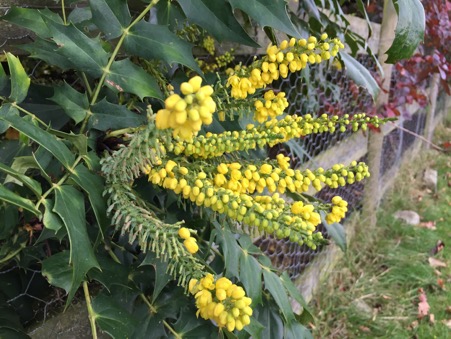
Mahonia is an evergreen shrub with holly like leaves that produces yellow racemes of fragrant flowers from November to March. Several species and varieties are available and in warm weather bees will work the flowers for nectar and pollen.
Large overgrown specimens can be cut back in early spring after flowering and will produce new growth that will flower the following autumn/winter.
October
Ivy (Hedera helix)
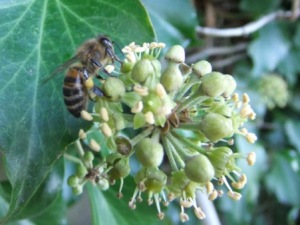 Ivy is an important source of nectar and pollen to honeybees at this time of year. Flowering late September to November and if warm enough flowers may still be found until late on in the year for bees to forage on. Pollen is consumed by workers in the autumn to enlarge the hypopharyngeal glands and fat bodies, allowing longer life of the winter bee.
Ivy is an important source of nectar and pollen to honeybees at this time of year. Flowering late September to November and if warm enough flowers may still be found until late on in the year for bees to forage on. Pollen is consumed by workers in the autumn to enlarge the hypopharyngeal glands and fat bodies, allowing longer life of the winter bee.
Research has shown that honeybees going into winter with low levels of protein in their fat bodies have :
- Shorter lives.
- Are susceptible to Nosema and EFB.
- Don’t winter well and the colony is likely to suffer from spring dwindling as nurse bees require protein to produce brood food.
by Stuart Hatton
